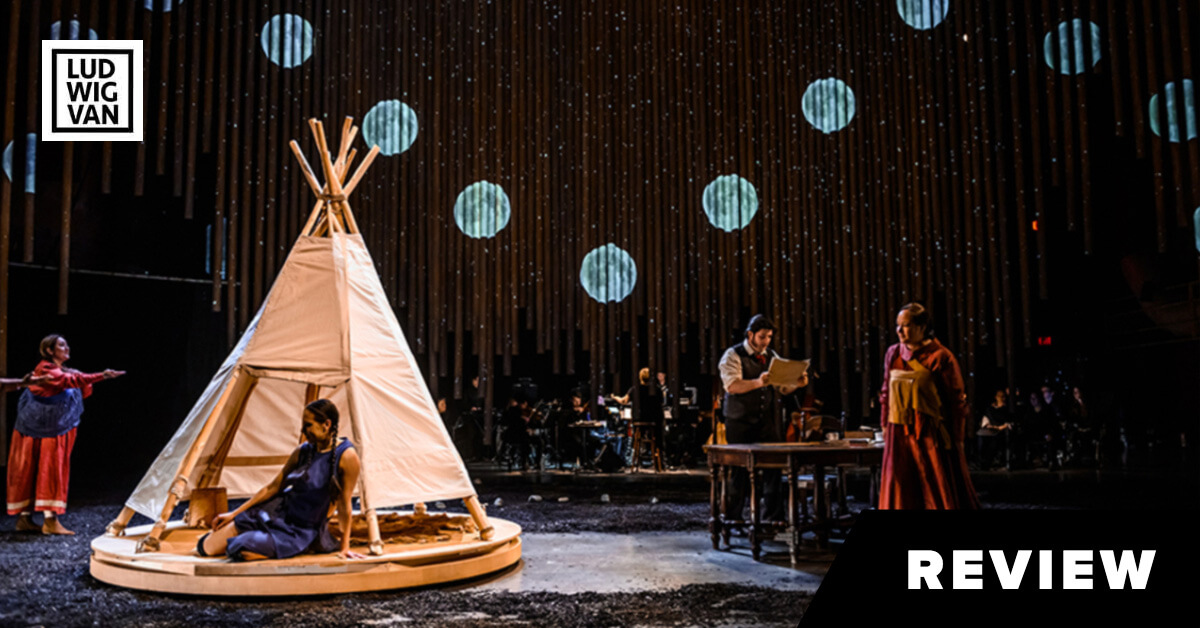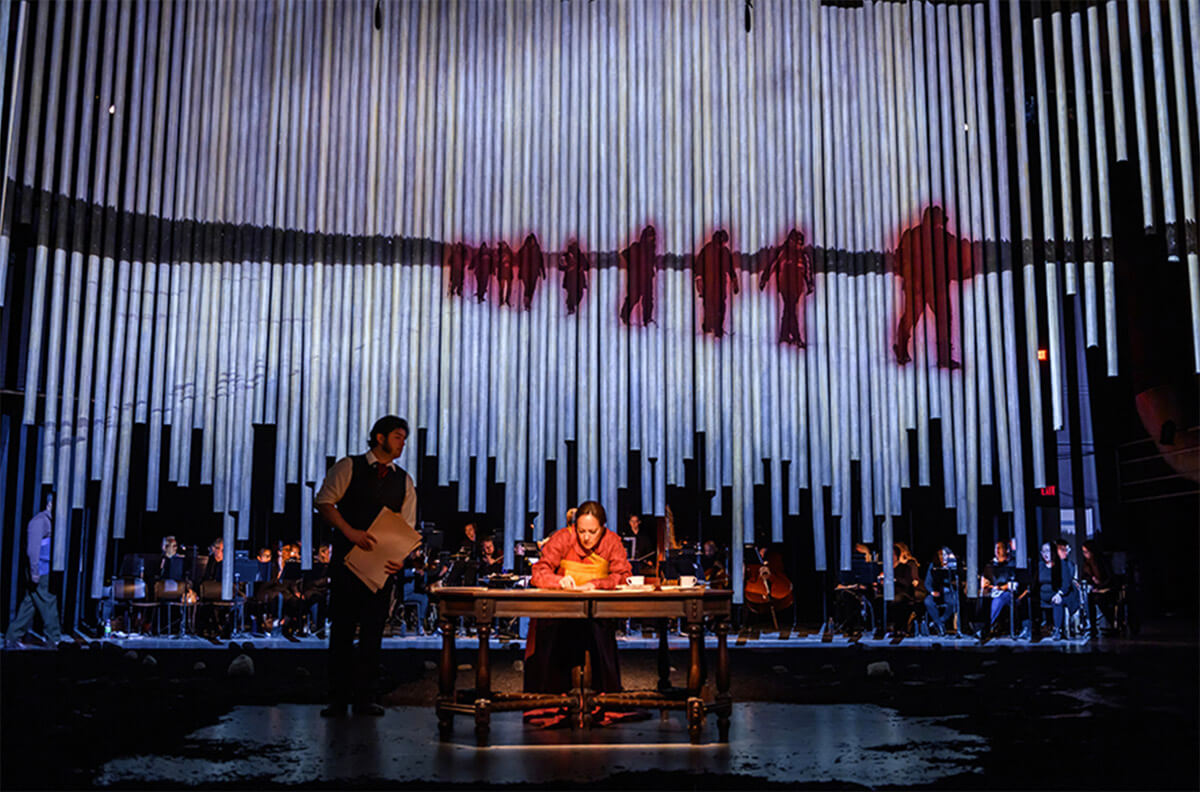Tapestry Opera’s latest co-production with Opera on the Avalon had all the signs of success, but a dragging narrative, mismatched score, and lack of imagination keep this profound story from resonating.

Libretto by Yvette Nolan And Music by Dean Burry. Music direction by Rosemary Thomson. Co-directed by Yvette Nolan and Michael Mori. At the Imperial Oil Opera Theatre through to May 25. Details here.
Shanawdithit, Tapestry Opera and Opera Avalon Newfoundland’s much-anticipated new work about a last survivor’s story of colonial encroachment and genocide of her people, opened last night to an enthusiastic sold-out crowd at the Imperial Oil Theatre. But, while the story furthered the path to broader reconciliation, there were times when it could have said a lot more and to greater effect.
Shanawdithit is certainly a story that needs to be told, voiced eloquently and in the most compelling way by the versatile mezzo-soprano Marion Newman, who brought to life the anima and very embodiment of the title role, all pre-eminently well set by a splendid collaborative group of Cree, Tr’ondëk Hwëch’in, and Mi’kmaq artists.
Her compelling story, about the last of the Beothuk tribe (contemporary Newfoundland), is tragic to the core. Her people exiled and annihilated over 250 years by settlers, Shanawdithit (1801-1829) is the last member of a vanished way of life who tells in actions, words and drawings her people’s essence that once blended body, soul and spirit with land, snow and wind.
Throughout, she is seen with the opera’s alternate star, dancer Aria Evans, who simply puts on a wonderful show, describing in lyrical sweeping movement every morsel of Shanawdithit’s anguish, outright anger and resignation to her fate. We needed more Aria Evans in this production, who clearly has far more talent to offer as Spirit companion to the deepest parts of these stories, more of which required detailed and nuanced telling.
And here was the problem. Dean Burry’s score is exemplary in its mixtures of twentieth-century style elements, some latent and others clear, but it seemed throughout that the music belonged in a different opera. The same may be said of acclaimed writer and playwright Yvette Nolan’s libretto and co-direction. Nolan is a superb writer and her book, Medicine Shows, was engrossing and important to read, especially if you want to understand even the first thing about Indigenous theatre, or theatre period, in our country today. Still, there was something that didn’t come across about Thursday night’s opera and somehow the overall impression ended up translating more as missed opportunity.
The opening of the opera, with an important blessing from Traditional Ojibwe Elder, Whabagoon, of Lac Seul Nation, set an appropriate tone for the evening. Her moving introductory words were essential to setting the mood of the opera. That’s because they reach for a common element of artistic and creative history among both peoples, indigenous and European, namely that the theatre or performing space is also a sacred space, one requiring a divine blessing. Yvette Nolan’s intimate understanding of that crucial element seeped persuasively into her libretto, at once about theatre as it was about healing and reconciliation.
But, as the opera moved forward past the usual declamations of colonial ignorance about indigenous ways, I found that the characters, largely in the foreground, had little to say. Clarence Frazer’s William Cormack, the well-intentioned documenter who wants to make amends for the complete disenfranchisement of the Beothuk by telling their stories (he induces Shanawdithit to describe her people’s lives in ten drawings), comes off as hollow and dramatically purposeless. I am sorry to say this, but moving Cormack to prominence cheapened the gift of Shanawdithit’s life and story. The static scenes in Cormack’s study under flat lighting felt unsubtle and stark, leaving little to contrast or imagination.
While it is true that Tapestry Opera sought to balance the “two sides of the story”, so to speak, and the workshopping was an extensive and detailed process trying to find the correct chemistry that would detail the many perspectives behind these stories both inaccurately told and those as yet untold, the result, in the end, was not really a story generous to Shanawdithit’s account or a spirit of theatre that would induce profound and transformational experiences of life, land and reconciliation so badly needed in our country today.

(Photo: Dahlia Katz)
A better idea would involve shady characters stepping out of subtly staged shadows, and briefly, much like history and flawed documentation itself, finally brought to a light of truth, in large part like the story and life of Shanawdithit herself. A greater myriad of lighting contrasts and effects were required along with more dance, more medicine, and above all, more thought-provoking stagecraft.
Cormack’s lines, including his declaimed singing and outsider’s perspective, however well-intentioned, simply resonated as empty expiating of post-colonial guilt. I needed to experience more of Shanawdithit’s stories through her drawings, more shadowy scenes of a hidden world finally revealed, but alas, a lack of imagination intervened at many points.
For example, Shanawdithit’s moving scene “You men of the world” required a better contrasting series of lighting cues and perhaps even video to offset the previous sketches showing Beothuk daily life, complete with Drying house and wigwams, all beautifully designed by Meagan Musseau from Marmateek design. Instead, what ought to have been a moving scene falls a little flat, with Aria Evans’ powerful dance to Michelle Olson’s excellent choreography stealing the show in the sketch that followed.
tIn fact, Aria Evans would have been put to more extensive use dancing the drawings into imaginative reality. Music could have been less dissonant in the atonal expressionist style. Or it could have been more meditative and textured, even in a minimalist style, particularly in the moving “How can I sing to descendants I will never have?” And again, here lighting could have been more effectively used with greater onstage movement, video, dance, and less harsh lighting.
Highlights included, definitively, Aria Evans’ vibrant and tortured movement and dance to the abduction of Demasduit, called “Mary March” by her captors who murder her husband and companions. Again, the murderers are in stark lighting, easily viewed as they walk on stage, instead of being hidden as dark crimes typically are. It was dramatically too obvious and stole yet again from Marion Newman’s superb singing and sterling vocal production. So it was with the anticlimax of Cormack confronting his feelings for Shanawdithit and her eventual passing at a tragic young age: great singing from Newman and Fraser, but flat staging that drained the story of dramatic self-discovery.
All in all, Tapestry Opera’s latest contemporary vehicle had all the thumbprints ready for success. But a dragging narrative throughout loaded with offsetting static scenes cast in willful contrast to the dynamism of Beothuk life and Shanawdithit’s reminiscences, in the end deprived the production of a chance to risk saying something more eloquent. It would have been better to see colonial characters step from the shadows and declaim their perspectives, recede, and then have Shanawdithit sing her responses via more carefully crafted staging, location, lighting, effects and especially dance.
We needed more Shanawdithit and less of everyone else, even in the crucial closing set pieces “We will not be disappeared” and “These are the descendants of Shanawdithit”, essential works to the story that felt a little understated and lacked both intimacy and a sacred message merging indigenous identity with transcendent timelessness. I liked the closing pieces well enough, but felt there was more to the intrinsic process of creating these works that didn’t adequately reach out to its audience.
Shanawdithit tells her story through a long history and across a vastness of time, her Beothuk descendants released for us as guiding spirits embodying both restoration of a very present truth and reconciliation with a bittersweet past. A mystical and medicinal approach to this kind of theatre, no less confrontational nor truthful, but preeminently spiritual in its flow-through, would have helped this production’s ethos more.
Libretto by Yvette Nolan And Music by Dean Burry. Music direction by Rosemary Thomson. Co-directed by Yvette Nolan and Michael Mori. At the Imperial Oil Opera Theatre through to May.
LUDWIG VAN TORONTO
Want more updates on classical music and opera news and reviews? Follow us on Facebook, Instagram or Twitter for all the latest.
- SCRUTINY | Opera Atelier’s Film Of Handel’s ‘The Resurrection’ A Stylish And Dramatic Triumph - May 28, 2021
- HOT TAKE | James Ehnes And Stewart Goodyear Set The Virtual Standard For Beethoven 250 - December 15, 2020
- SCRUTINY | Against the Grain’s ‘Messiah/Complex’ Finds A Radical Strength - December 14, 2020



